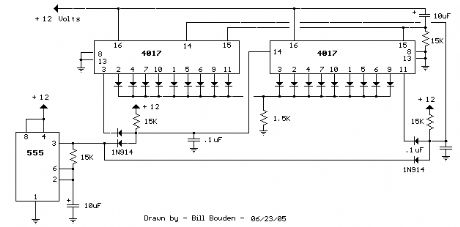
SIMPLE ELECTRONIC
CODE LOCK
The circuit diagram of a simple electronic
code lock is shown in figure.
A 9-digit code number is used
to operate the code lock.
When power supply to the circuit is
turned on, a positive pulse is applied to
the RESET pin (pin 15) through capacitor
C1. Thus, the first output terminal
Q1 (pin 3) of the decade counter IC (CD
4017) will be high and all other outputs
(Q2 to Q10) will be low. To shift the high
state from Q1 to Q2, a positive pulse must
be applied at the clock input terminal (pin
14) of IC1. This is possible only by pressing
the push-to-on switch S1 momentarily.
On pressing switch S1, the high state
shifts from Q1 to Q2.
Now, to change the high state from
Q2 to Q3, apply another positive pulse at
pin 14, which is possible only by pressing
switch S2. Similarly, the high state can
be shifted up to the tenth output (Q10)
by pressing the switches S1 through S9
sequentially in that order. When Q10 (pin
11) is high, transistor T1 conducts and
energises relay RL1. The relay can be
used to switch ‘on’ power to any electrical
appliance.
Diodes D1 through D9 are provided
to prevent damage/malfunctioning of the
IC when two switches corresponding to
‘high’ and ‘low’ output terminals are
pressed simultaneously. Capacitor C2 and
resistor R3 are provided to prevent noise
during switching action.
Switch S10 is used to reset the
circuit manually.
Switches S1 to S10
can be mounted on a keyboard panel,
and any number or letter can be used to
mark them. Switch S10 is also placed
together with other switches so that any
stranger trying to operate the lock frequently
presses the switch S10, thereby
resetting the circuit many times. Thus,
he is never able to turn the relay ‘on’. If
necessary, two or three switches can
be connected in parallel with S10 and
placed on the keyboard panel for more
safety.
A 12V power supply is used for the
circuit. The circuit is very simple and can
be easily assembled on a general-purpose
PCB. The code number can be easily
changed by changing the connections to
switches (S1 to S9).












 SIMPLE ELECTRONIC
SIMPLE ELECTRONIC



 Parts:
Parts:
 The continuity tester is a handy adjunct to an ohmmeter. The unit or component whose continuity is to be checked is connected between terminals E1 and E2 (which may be probes or croc clips). The test current then flowing through the unit/component on test causes a potential drop across resistor R2, which is applied to the non-inverting input of buffer IC2. The output of the op amp is applied to transistor T1, in the emitter circuit of which there are a number of parallel-connected light-emitting diodes. Each LED is in series with a zener diodes and a resistor. The zener diodes have dissimilar zener voltages as shown in the diagram. When the drop across R2 exceeds the sum of base-emitter voltage of T1, a zener voltage, and the threshold voltage of the LED in series with that zener diode, the relevant LED lights. which resistance value of the unit/component on test a particular LED lights. Bear in mind, however, that these values depend to some extent on the type of LED, and also that the zener voltages are subject to tolerances. Serious deviations may be corrected by the addition of a standard diode or a Schottky diode. It is also possible to add branches to individual requirements, or to use a bar display instead of LEDs. It is important that the op amp used has a rail-to-rail output since the input voltages as well as the output may rise to the peak supply voltage. This requirement is met by the MAX4322 as used in the prototype.
The continuity tester is a handy adjunct to an ohmmeter. The unit or component whose continuity is to be checked is connected between terminals E1 and E2 (which may be probes or croc clips). The test current then flowing through the unit/component on test causes a potential drop across resistor R2, which is applied to the non-inverting input of buffer IC2. The output of the op amp is applied to transistor T1, in the emitter circuit of which there are a number of parallel-connected light-emitting diodes. Each LED is in series with a zener diodes and a resistor. The zener diodes have dissimilar zener voltages as shown in the diagram. When the drop across R2 exceeds the sum of base-emitter voltage of T1, a zener voltage, and the threshold voltage of the LED in series with that zener diode, the relevant LED lights. which resistance value of the unit/component on test a particular LED lights. Bear in mind, however, that these values depend to some extent on the type of LED, and also that the zener voltages are subject to tolerances. Serious deviations may be corrected by the addition of a standard diode or a Schottky diode. It is also possible to add branches to individual requirements, or to use a bar display instead of LEDs. It is important that the op amp used has a rail-to-rail output since the input voltages as well as the output may rise to the peak supply voltage. This requirement is met by the MAX4322 as used in the prototype.


